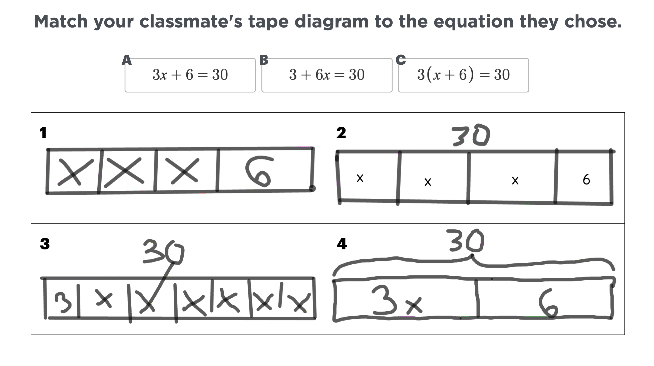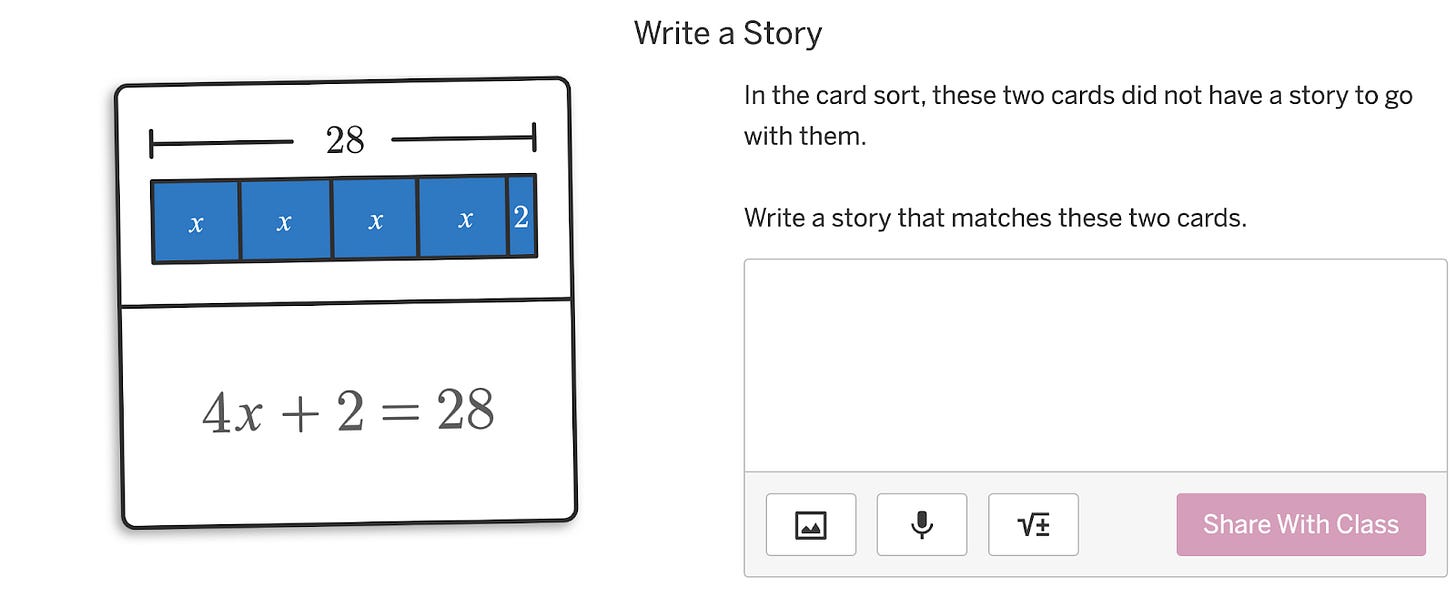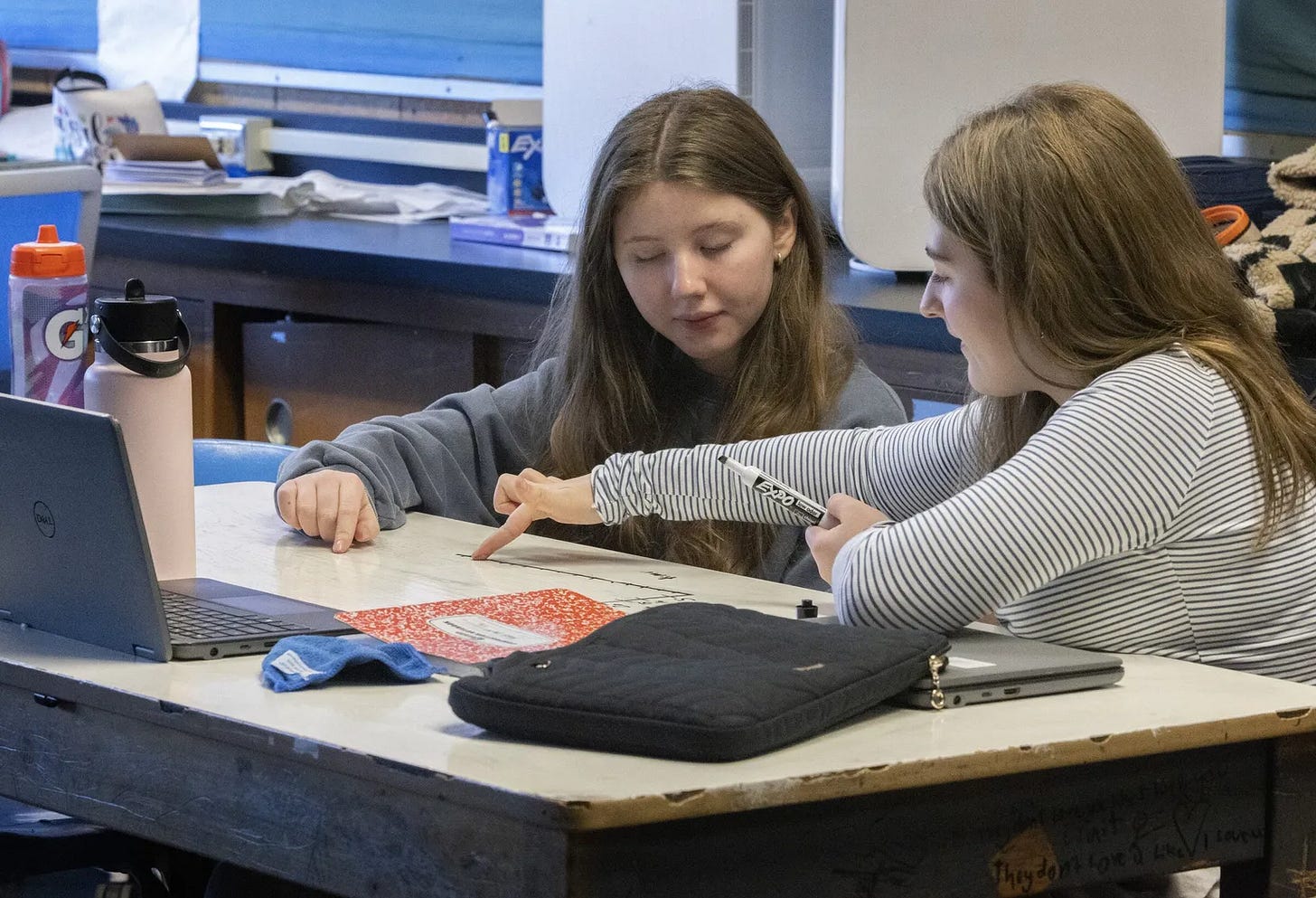Let me tell you about the two most effective moments from a class I taught last week and what they had in common and what it all means.
On one screen, we give students three equations. They choose one and turn it into a “tape diagram,” which is a representation that helps students learn to solve the equation.
Teachers often respond to students in a couple of common ways here:
They talk about the right answers.
They ask students to share their answers.
Both responses risk brain death. Neither one necessarily tells students, “There is a task for you here beyond listening.” Neither one necessarily sets up a shelf in a kid’s mind to help them structure the ideas they’re hearing.
Matchy Match is a different option.
What I did was pretty simple. I grabbed work from four students—the equation they chose and the tape diagram they sketched. Then I mixed them up and asked students to unmix them up—to match them together. “Tell your neighbor how you think the equations and diagrams match up,” I said, and please believe me, reader, when I say the class buzzed with ideas and debate.
Here is the interesting thing: I could have given those kids the exact same equations and tape diagrams as a prefabrication and my intuition here is that the students would have been much less interested, given me much less of their finite attention, and consequently learned a lot less than they did when I made them the curriculum.
Kids love it when they are the curriculum.
Later in the lesson, we give students an equation and a tape diagram and ask them to write a story that could have produced both. Rather than share my story, rather than just share their stories, I packaged four of their stories up with a question to give them a task beyond listening. I turned the kids into the curriculum and again the class buzzed with ideas about which one was different and what equation that student actually created.
How can we make these kinds of moments more common for more students? IMO the main challenges here include:
Curriculum that invites student thinking that is diverse rather than uniform.
Pedagogies that turn that student thinking into more student thinking—deepening and broadening it.
Beliefs about students and the value of their informal developing thinking relative to the value of formal canonical thinking.
I should probably be more modest but I consider (a) a solved problem. I review hundreds of classrooms worth of data from our curriculum monthly and I am never less than dazzled by the kinds of thinking I see from students.
The typical approaches to (b) and (c) involve teacher professional development, which is important and sometimes effective. But I am spending upwards of 50% of my working life right now trying to develop teacher pedagogies and beliefs through digital tools and if that is of interest to any of you, smash reply and let’s make each other smarter.
Upcoming Presentations
Last year, I was invited to speak at ASU+GSV’s AIR Show, an event that is extremely optimistic about AI. (“AIR” is an abbreviation for “AI Revolution.”) I gave a talk so candid I assumed it would get me uninvited from future events but it was one of the most watched talks at the show and now I am going back again in April to try to do the job right.
Featured Comments
A lot of 'personalized' apps effectively cut out teacher expertise, and some of the new tools seem to encourage the kind of cognitive offloading that would prevent teachers from developing expertise, so the tools are replacing a lot of the work that teachers would otherwise do, but at a perpetual novice level of quality.
Odds & Ends
¶ The Seattle Times depicts the classroom of the future. I love this article and not just because I’m quoted in it. Rather, because it depicts classrooms that are multimedia in the truest sense of the word. Check out the photos of classrooms that are undominated by any one media, that are nourished instead by screens, paper, conversation, white boards, etc, sometimes simultaneously. People are rightly concerned about screen time in classes, but that’s in large part because screens so frequently crowd out other media. Are the students in the photo above engaged in screen time or paper time or whiteboard time or conversation time? IMO the answer is as it should be: yes.
¶ Very related: Dylan Kane on the Videogamification of Learning. If you’re building in edtech, you might imagine your product as the thing that students open and close in a tab on a device. But Dylan reminds us that there is an entire attention economy surrounding the tab and the device, that opening and closing the device itself incurs a switching cost that is non-trivial.
If I want to pause students to discuss something or address a common issue, Chromebooks must be closed. Tilting screens down doesn't work. This means those discussions often don't work very well — it takes a minute to get everyone to close their Chromebooks, and students have to log back in when they open Chromebooks again, so there's a big transaction cost. But that's the only way to get every student to listen.
That’s so real. Yes, edtech needs to worry about the pixels on the page but it needs to worry just as much about the environment in which the pages are opened and used.
¶ Unbound Academy takes another L, this time in Lancaster, PA, where the school district rejected its application for its virtual charter school. Unbound Academy, if you’ll recall, claims their schooling model is heavy on AI and light on teachers. (I reviewed those claims earlier this year.) It seems Lancaster was not convinced.
“The application failed to demonstrate sustainable support from the community, and did not provide detail on strategies for meaningful parent and community involvement,” Wynn wrote in a statement after the hearing. “It also relies on overly ambitious revenue projections and indicates a limited understanding of the local clientele and their educational priorities.”
¶ Betsy Corcoran (EdSurge co-founder) and Jeremy Roschelle (professional smartypants at Digital Promise) have a new podcast called Future Fluent and I’m on as their third guest talking about AI and math.
¶ Dora Demszky’s lab at Stanford is hosting a teacher summit on AI. It is application only but includes funds for travel. Demszky and her team study teacher use of AI in ways that make me feel smarter about teaching and AI, so I’d definitely recommend giving the application a look.










I completely agree with the instructional moves here and how presenting a non-routine task like match the solution to the original equation will produce much richer and more diverse thinking from students. I think what is sometimes lost in these experiences (especially when tech is involved) is all the minute teacher moves needed to maximize this instructional move for student learning. For example:
- having students tent laptops after their initial exploration before beginning a whole class discussion
- sequencing student ideas so that they build toward a common understanding (also requires monitoring and listening while students discuss with partners)
- asking questions that elicit student thinking that is aligned to a main idea (these can be somewhat pre-planned based on the content)
- teaching students norms for how to respond to one another’s ideas (ask a follow-up question, build on an idea, disagree with an idea etc.)
- reinforcing norms that create a safe space for sharing ideas such as: “disagree with ideas, not people”
This is not an exhaustive list. Sometimes people mistakenly assume putting the tech activity in front of students is the teaching and don’t understand why students aren’t able to arrive at a common conceptual understanding from it (this can also happen with non-tech related tasks). The more diverse the student thinking related to a task, the greater the need for strong facilitation of discussion to bridge to common conceptual understanding IMO.
Your talk at AIRShow last year was spectacular! Amongst the swirling sea of "AI Hype", you shared the most teacher-centered presentation. Very excited to hear another one this year!